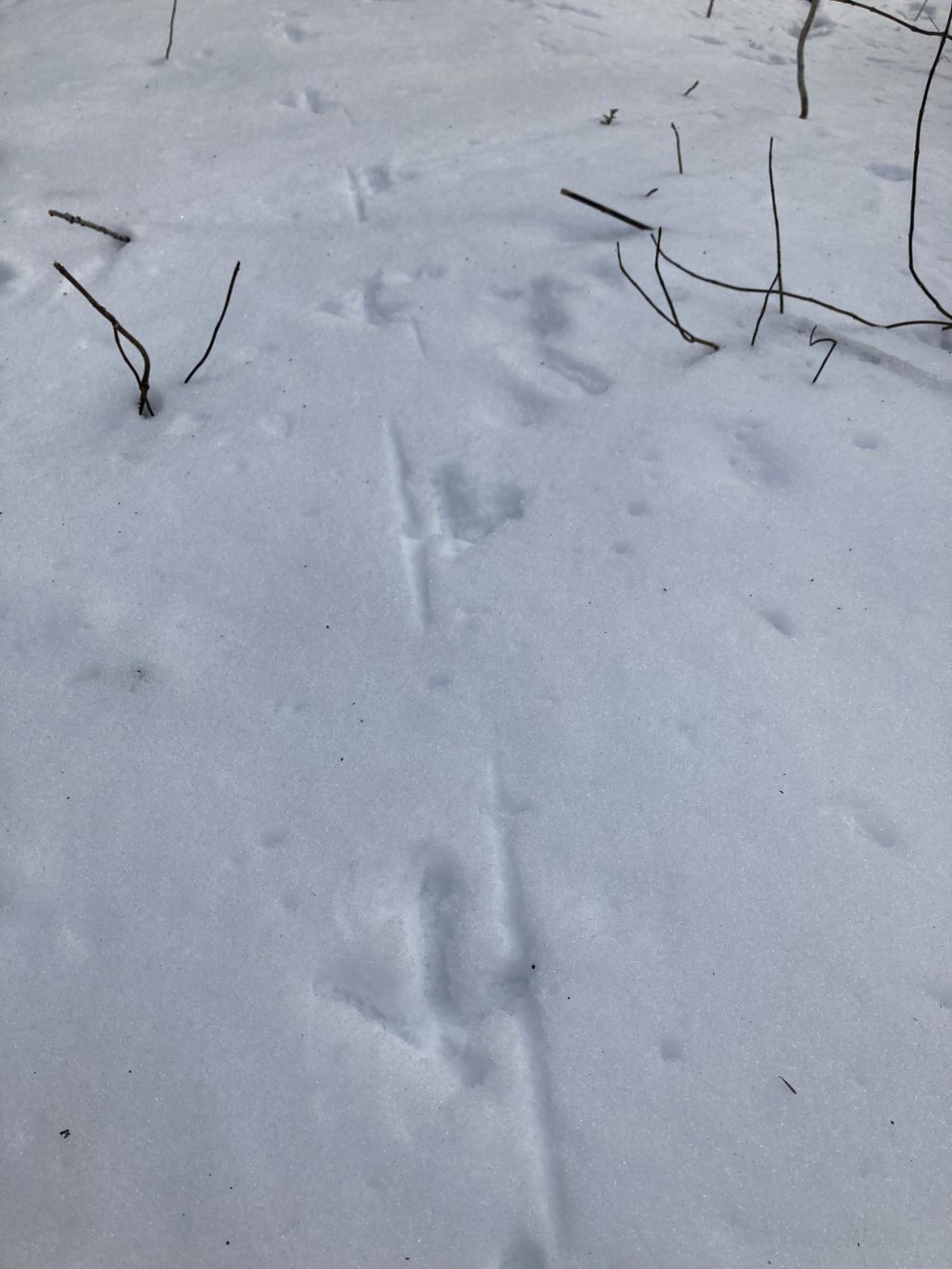Almanac: Dinosaur Tracks

Wild turkey tacks, Bear Swamp, Ashfield, MA. Photo: Stephen Braun
I was hiking with a friend recently in the wonderfully varied terrain of the Bear Swamp reservation west of Ashfield. There was a thin layer of fresh snow on the ground, which was perfect for preserving all manner of animal tracks. In a low area of forest we came upon the unmistakable signs that a pack of small dinosaurs had recently cavorted in the area.
At least that’s what sprang to mind as I looked at them. They were, of course, the tracks of a group of wild turkeys. But the tracks reminded me vividly of the very similar sets of tracks preserved in stone and displayed at Amherst College’s Beneski Museum of Natural History. (Take a look at the tracks used on the home page of the museum’s website and compare them to my photo.) When I look at wild turkeys—easy to do around here because they’re so plentiful—it’s very easy to see the theropod dinosaurs from which they descended. Those thick scaley legs and big three-toed feet, in particular, look, to me, very reptilian.
The tracks I saw had a curious feature: a straight line that seemed to alternate from side to side along the tracks of the feet. I figured it was left by a tail feather—or feathers. When I checked it out, back home, I discovered that the marks actually result from the tendency of turkeys to drag their big middle toe as they walk. So they’re toenail tracks.
Wild turkeys belong to the same family as grouse, pheasants, peacocks, and chickens. These birds are all gallinaceous, meaning they are primarily ground-dwelling and ground-feeding. Wild turkeys are social, preferring the company of small flocks to the single life. Though they spend most of the day on the ground, they spend their nights roosting safely in trees.
One of our heaviest wild birds, turkeys would rather walk than fly, though they are agile and adept fliers when they need to be. They are primarily vegetarian (and probably wish humans were too), feeding on nuts, berries, and seeds, though they’ll also eat insects, small snakes, or whatever else they can catch.
The roughly 250 million domestic turkeys raised each year in the U.S. are descendants of wild turkeys domesticated by the native cultures of what is now Mexico and the southwest U.S. The Spanish, exploring and ravaging those areas in the 15th and 16th centuries, brought turkeys back to Europe where they were further domesticated. Like chickens, domesticated turkeys have lost most of the savvy and survival instincts of their wild cousins. For instance, when wild turkey chicks hear their mother’s alarm call, they immediately become rigid and motionless. Domestic turkey chicks, hearing the same call, continue to walk around–a behavior that would make them easy prey in the woods.
One last thing about the turkey/dinosaur connection: it holds the answer to the hoary old riddle “Which came first, the chicken or the egg?” All reptiles, prehistoric or modern, lay eggs. The eggs are sometimes leathery instead of hard like a chicken’s egg, but they have yolks and whites and are perfectly eggy in all other respects. The members of the Psudosuchia order—the ancestors of all birds, chickens and turkeys included—also laid eggs. Eggs therefore, were around for millions of years before chickens came along.
Almanac is a regular Indy column of observations, musings, and occasional harangues related to the woods, waters, mountains, and skies of the Pioneer Valley.
Stephen Braun has a background in natural resources conservation, which mostly means he is continually baffled by what he sees on explorations of local natural areas. Please feel free to comment on posts and add your own experiences or observations. You can also email at: braun.writer@gmail.com.

Thanks for these columns Steve. Since the start of the pandemic we have spent far too little time in nature. Your weekly accounts inspire us to get back on the trails.
And, of course, eggs go back to essentially all multicellular eukaryotic organisms — but I do wonder if essentially all the latter … taste like chicken? 😉